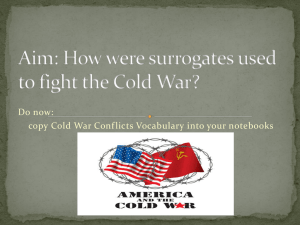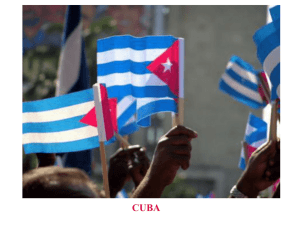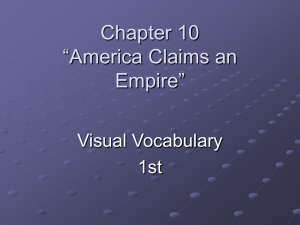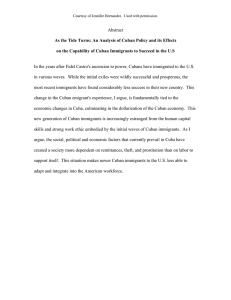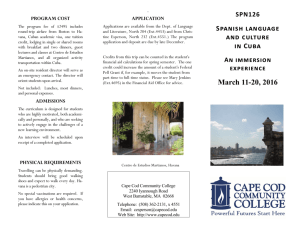W Discourses of/on Nostalgia: Cuban America’s Real and Fictional Geographies
advertisement
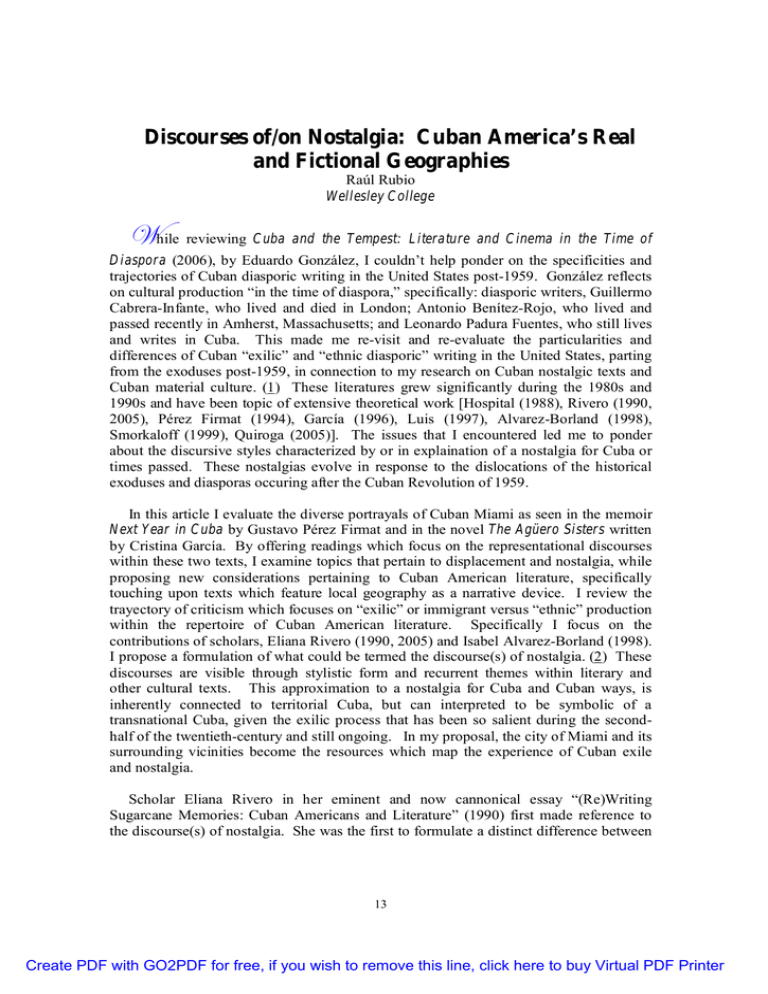
Discourses of/on Nostalgia: Cuban America’s Real and Fictional Geographies Raúl Rubio Wellesley College While reviewing Cuba and the Tempest: Literature and Cinema in the Time of Diaspora (2006), by Eduardo González, I couldn’t help ponder on the specificities and trajectories of Cuban diasporic writing in the United States post-1959. González reflects on cultural production “in the time of diaspora,” specifically: diasporic writers, Guillermo Cabrera-Infante, who lived and died in London; Antonio Benítez-Rojo, who lived and passed recently in Amherst, Massachusetts; and Leonardo Padura Fuentes, who still lives and writes in Cuba. This made me re-visit and re-evaluate the particularities and differences of Cuban “exilic” and “ethnic diasporic” writing in the United States, parting from the exoduses post-1959, in connection to my research on Cuban nostalgic texts and Cuban material culture. (1) These literatures grew significantly during the 1980s and 1990s and have been topic of extensive theoretical work [Hospital (1988), Rivero (1990, 2005), Pérez Firmat (1994), García (1996), Luis (1997), Alvarez-Borland (1998), Smorkaloff (1999), Quiroga (2005)]. The issues that I encountered led me to ponder about the discursive styles characterized by or in explaination of a nostalgia for Cuba or times passed. These nostalgias evolve in response to the dislocations of the historical exoduses and diasporas occuring after the Cuban Revolution of 1959. In this article I evaluate the diverse portrayals of Cuban Miami as seen in the memoir Next Year in Cuba by Gustavo Pérez Firmat and in the novel The Agüero Sisters written by Cristina García. By offering readings which focus on the representational discourses within these two texts, I examine topics that pertain to displacement and nostalgia, while proposing new considerations pertaining to Cuban American literature, specifically touching upon texts which feature local geography as a narrative device. I review the trayectory of criticism which focuses on “exilic” or immigrant versus “ethnic” production within the repertoire of Cuban American literature. Specifically I focus on the contributions of scholars, Eliana Rivero (1990, 2005) and Isabel Alvarez-Borland (1998). I propose a formulation of what could be termed the discourse(s) of nostalgia. (2) These discourses are visible through stylistic form and recurrent themes within literary and other cultural texts. This approximation to a nostalgia for Cuba and Cuban ways, is inherently connected to territorial Cuba, but can interpreted to be symbolic of a transnational Cuba, given the exilic process that has been so salient during the secondhalf of the twentieth-century and still ongoing. In my proposal, the city of Miami and its surrounding vicinities become the resources which map the experience of Cuban exile and nostalgia. Scholar Eliana Rivero in her eminent and now cannonical essay “(Re)Writing Sugarcane Memories: Cuban Americans and Literature” (1990) first made reference to the discourse(s) of nostalgia. She was the first to formulate a distinct difference between 13 Create PDF with GO2PDF for free, if you wish to remove this line, click here to buy Virtual PDF Printer the nostalgic literary expressions of the Cuban exile [‘immigrant’] writer vis a vis that of the Cuban American “ethnic” writer. A Cuban writer tends to be more a critical observer of, rather than a participant in, North American realities. And she or he will enter more into a writing dialogue with the Cuban insular past and/or present. On the other hand, a Cuban American writer would be the younger, more easily adapted individual, who immigrating as a child or young adolescent, is only part time practitioner –if at all- of the Cuban nostalgia discourse (169). Furthermore, Rivero explains her title metaphor which also supports this distinction. In the nostalgic discourse of Cuban writers the presence of palm trees and sugar cane is a constant. It can be said that the words sugar and sugar cane, and the images created by them, are metaphors for the essence of what it means to be Cuban. In the works of Cuban authors, then, and in those by younger Cubans in transition, “writing sugarcane memories” is an image that figuratively represents the re/creation of mother country motifs in a subtle form of nostalgic discourse (175). These parameters, which Rivero formulated over fifteen years ago, have been modified and amplified into what in her recent book, Discursos desde la diáspora (2005), she calls“diasporic imaginaries” or what I would claim are diasporic discourses based on re-creating imaginaries on home and homeland. The stylistics of these “diasporic imaginaries,” eminent in both the literature of Cuban exiles and Cuban American “ethnic” o “hyphenated” writers, are still visible in writing today. (3) Through the years, however, the parameters have blurred and become versatile, creating in many instances hybrid intersections of the traditional stylistics of each category of writer. For example, throughout Cristina García’s novel the stylistics of the narrative include both the Cuban exilic scope and the Cuban American ethnic one. Some sections specifically deal with characters that are perpetually dealing with exile, and therefore the narrative is linguistically inclined toward Spanish and/or Spanglish. On the other hand, some sections pertain to characters that are ethnic Americans or American born Cubans, yet feature characterizations that frame a neverending fixation on Cuba. Given this, I would venture to say that the literature of Cuban America has an established evolution involving experiments in linguistic usage and cultural translation. Certain are themes pertaining to the way things were, a nostalgia for the homeland, past times, lost times, and the process of transculturation, all salient throughout both Cuban immigrant and Cuban American ethnic writing. My proposal here lies in pointing to nostalgia as a detrimental site within the discourses found in both of these types of texts. I place most literary or cultural production pertaining to the Cuban diaspora within one of two general arenas; one arena encompases texts that utilize the “discourses of nostalgia” as a narrative means to 14 Create PDF with GO2PDF for free, if you wish to remove this line, click here to buy Virtual PDF Printer exemplify the Cuban experience; the second being texts that formulate “discourses on nostalgia” in order to explain the Cuban experience, texts like Pérez-Firmat’s memoir, which establish a critique of the nostalgia habit. Scholar Isabel Alvarez Borland alludes to these differences in her book Cuban American Literature of Exile: From Person to Persona (1998). She specifies in her introduction what is most pertinent to my discussion here, the critical importance of “history within the fiction” of Cuban America. What she labels as “the trajectory of displacement,” both personal and collective histories, are unique, diverse, traumatic, and all at once emblematic of the varied Cuban diasporic experiences. Yet the key to the transfer of real history to literary or cultural production lies in the art of fictional process, one which Alvarez Borland illustrates beautifully utilizing anecdotes by Peruvian writer Mario Vargas Llosa on narrative technique. For many of these texts, the “telling” of historical accounts, whether real or fictional, displays what can be detailed as a dialectic of nostalgia, or an evocation or negotiation of history. This dialectic of nostalgia is problematic to frame empirically given that not all texts are wholly or organically nostalgic, yet the praxis of nostalgia is a feature that is noticeably present in many. In general terms nostalgia is defined as “the state of being homesick, a sentimental yearning for return to a past period or irrecoverable condition” (Merriam Webster’s, 1997). More specifically I would add that nostalgia in the Cuban case, is felt as a community trait, a shared experience, a national form, a common theme, or a patriotic emotion. Of course, these claims could fall into the category of generalization, however, fervent themes of nostalgia are recurrent in many a diasporic text. Scholar André Aciman supports this idea in his edited book Letters of Transit: Reflections on Exile, Identity, Language, and Loss writes “the one thing exiles do almost as a matter of instinct is “compulsive retrospection.” With their memories perpetually on overload, exiles see double, feel double, are double” (13). We can say then that this “compulsive retrospection” is a duality of emotions pertaining to a “lost” time. This feelings are based on the past. Possibly a past that may or may not be as accutely represented in the portrayal, one that may, through time, gain mythic proportions. In Eva Hoffman’s essay “The New Nomads” which appears in Aciman’s edited Letters of Transit two arguments are made that are critical for this discussion. The first supports the proposal that establishes Cuban Miami as a transnational clone of Cuba. She says: “The nostalgia of exiles for their birthplace has undoubtedly often been augmented by this conjunction of geographic and patriotic longing” (58). This dual connection is indeed ever present in the life of the exile in the Cuban case. For those that physically left the island they are perpetually dealing with that closure and adjusting to the new home, while fixated on their original homeland. For those born outside of Cuba, the territorial space is many times a fictional space that they have never come in contact with. Miami then, becomes a second home, a new homeland, a clone of the original, a copy. Hoffman’s second argument takes this connection and transfers it to the exilic position of creating texts that exemplify this perpetual nostalgia. These texts then exemplify an “imagined” community, traditionally featured as “one” monolithic community with one 15 Create PDF with GO2PDF for free, if you wish to remove this line, click here to buy Virtual PDF Printer discourse. She postulates on the fantasies, real or fictional, associated with the state(s) of nostalgia: The nostalgic addiction of the exilic narrative is a psychic split –living in a story in which one’s past becomes radically different from the present and in which the homeland becomes sequestered in the imagination as a mythic, static realm. That realm can be idealized or demonized, but the past can all too easily become not only another country but a space of projections and fantasies. Some people decide to abandon the past, never to look back. For others, the great lure is nostalgia –an excess of memory. (52) In Cuban terms no one defines it better than Ricardo Ortíz in his article Café, Culpa and Capital: Nostalgic Addictions of Cuban Exile. He describes an exile’s addiction to nostalgia by using a metaphorical analysis of Cuban café: …the more general nostalgizing practices in Cuban exile literature and culture. It bears repeating here that, in and out of exile, Cubans are caught in a kind of chronic and aporetic addiction to an idea, and this conceptual addiction manifests itself phenomenally in all manner of substantial addictions. These in turn trouble if not foreclose precisely the fantasy of linear time that feeds their congruent fantasies of return, reunification and restitution, fantasies on which they’re hooked, and of which they take “hits” at least as often as they drink coffee. (70) This addiction to an idealized Cuba to which Ortíz refers to is in fact subsequently observed in the literatures of Cuban America. Of most interest to this project is the transfer of this idealized Cuba onto the transnational geographic spaces within the United States. Specifically here, the locality of Miami, home to a diverse Cuban community. In Gustavo Pérez Firmat’s memoir Next Year in Cuba: A Cubano’s Coming of Age in America the experience of being a child in Miami and later discussions about the city, once the author was no longer living there, explicitly displays a “discourse of nostalgia.” Rememberances of things past, in connection to family and his childhood home in Cuba are transfered to his early days in Miami. However, within the general parameter of the narrative there are explanations about the importance of territorial Cuba for exiles (and Cuban-American ethnics) as well a study of Cuban-ways and Cuban-things, all inline with a “discourse on nostalgia.” Pérez Firmat extrapolates both of the stylistics of the“discourses of/on nostalgia” while explaining how memory and loss is nevertheless a commonplace for both. Pérez Firmat writes: If for my father Cuba is a burdensome fact, and for my children an enduring fiction, for one-and-a-halfers like me, the country of my birth is a blend of both fact and fiction. Since my recollections of the island are an indeterminate mix of eyewitness and hearsay, what I know is mixed in 16 Create PDF with GO2PDF for free, if you wish to remove this line, click here to buy Virtual PDF Printer with what I have been told. My memories merge with other’s dreams. (12) Here the author establishes the differences (and in some instances commonalities) by which Cuba is seen and felt through the eyes of exile and ethnic participants. What Pérez-Firmat points to as a “burdensome fact” is the historical aspect touched upon earlier, yet at once he parallels this to the other meaning, an “enduring fiction,” for the yournger generations for whom Cuba is a mythical space. By specifiying these differences, Pérez-Firmat alludes to the forms that nostalgia takes, at once, based on reality and fiction, created and transferred between individuals of distinct generations. To describe the feeling of exile Pérez Firmat uses a metaphor that I consider relevant to the understanding of nostalgia for Cuban Americans like him. He states: “Refugees are amputees. Someone who goes into exile abandons not just possessions but part of himself. Just as people who lose a limb sometimes continue to ache or tingle in the missing calf or hand, the exile suffers the absence of the self he left behind” (22). This absence of a part of oneself is reflected in the memory of one as a whole, and this in turn is what produces nostalgia. This yearning for something irrecoverable leads to drawn out, possibly idealized versions of what was once a reality. In a first reading of Pérez Firmat’s memoir the most common revelation one may take is that there is a noticeable degree of nostalgia. However, the author’s claim is that his text is “not written from nostalgia” and alludes to an exile’s intention of “forgetfulness.” This “forgetfulness” may be a purposeful response to the complex exile process. I consider that by “forgetting” what is too painful to remember and consciously or unconsciously “recreating” a mélange of both fact and fiction, an exilic or ethnic participant may move forward in their new environment. In this “forgetting” and “recreating” we can observe the formulation of a nostalgic space, based on both the memory of homeland or and the new home country. Pérez Firmat analyzes these spaces of nostalgia by describing how the exile community has dealt with geography and history. He mentions a Miami exhibit on the history of Havana. Pointing out that “to judge by the exhibit, on January 1, 1959, Havana vanished…there was not one artifact, one photograph from the last thirty years, as if Havana had disappeared the day Fidel’s milicianos marched in” (84). He then comments on the most famous area labeled “Little Havana” a neighborhood of Miami that has been predominantly Cuban: “Anything one needed could be found on Calle Ocho, which is located in the heart of Little Havana…it was a golden cage, an artificial paradise, the neighborhood of dreams” (82). This quote exemplifies a version of what “Little Havana” has been for some members of the Cuban community in Miami. For them, Miami was built on the adoption of the American dream and the collective memories of exile. Pérez Firmat then goes on to propose that visitors to the exhibit he refered to could potentially step outside of the museum onto Calle Ocho, Little Havana U.S.A., and continue the historical tour of Havana right there in the United States. He claimed that 17 Create PDF with GO2PDF for free, if you wish to remove this line, click here to buy Virtual PDF Printer the geographical space of “Little Havana became the greater Havana” and in many ways it did. Through the years nostalgia materialized in a specific urban area of Miami which in fact created a microcosmic “Little Cuba” right in Florida, imitating certain streets and store facades reminiscent to thoese existent in Cuba . (4) For Pérez Firmat, Miami is a place that represents home, a possibility “to breathe, to inhale Cuban oxygen, to let off steam. Miami nourished my nostalgia and healed my loneliness” (252). Here then, readers observe the juxtaposition of both fact and fiction within Pérez Firmat’s memoir genre. Through Miami then, the author’s reality, history and present, was meshed with the composite of nostalgia, real and fictional substance, on which the narrative is based, giving texture to both discourses of and on nostalgia. Along similar lines, Cristina García’s novel The Aguero Sisters is and is not a typical nostalgic text. Sections of the text utilize a “discourse of nostalgia” in order to demonstrate the commoness of this romanticized practice for Cuban exiles. Like her first novel, Dreaming in Cuban, it has a magical epic feeling of transnationalism with vivid descriptions of Cuba’s flora and fauna and Miami’s glitziness, beaches and residents. However, the patina of territorial Cuba, of a time long ago, takes precedence. It also includes representations of the current day Miami Cuban community, portraying it in a light way instead of a serious manner. The narrative is devoted to the development of individual characters in their respective landscapes, rather than illustrating the wholistic depth of the exile experience. García plays into the reputation of Miami Cubans pertaining to fervant politics and fierce nostalgia in a comical form. With close character development, García presents a cast of individual histories of mostly women, expanding their particular circumstances and views. The plot takes place in Miami, Key Biscayne, and Havana, some occurences happening concurrently and others at different time spans. The protagonists are two sisters separated during childhood: Constancia, the exiled sister who first lives in New York and later in Miami; and Reina, the sister who remained in Cuba. From the beginning of the novel there are descriptions that define the characters’ positions towards Miami. For example, Constancia is unique in that she is not representative of the Miami exile Cuban, who traditionally partakes in nostalgic habits. “Constancia doesn’t consider herself an exile in the same way as many of the Cubans here. In fact, she shuns their habit of fierce nostalgia, their trafficking in the past like exaggerating peddlers” (García 46). It is clear then that García intends to include the diverse positions involved within the exile spectrum. She includes various entries that vividly characterize the community in Miami. In the next quote she reveals some aspects of nostalgia that are non-traditional: Miami is disconcerting to her, an inescapable culture shock, the air thickly charged with expiring dreams. The light is binding too, a sentence to the past, to her life in Cuba. Everywhere, there is a mass of disquieting details. The deep fried croquettes for sale on the corner. The accent of the valet who parks her car. Her seamstress’s old fashion stitching. And the songs, slow as regret, on the afternoon radio. (46) 18 Create PDF with GO2PDF for free, if you wish to remove this line, click here to buy Virtual PDF Printer The reader observes how the details of nostalgia are not to the liking of Reina, the island sister, who comes to visit, and experiences the exilic nostalgia in Miami firsthand. Her attitude towards nostalgia proves very different than those observed in the “practitioners” of of nostalgia, and that portrayed in Pérez Firmat’s text. Further into the novel, Constancia, the exile sister, uses her insight of Cuban exile culture to launch an entrepreneurial idea. She manufactures products that would appeal to the Cuban exile market. Her beauty line includes a vast number of “face and body products for every inch of Cuban womanhood: Ojos de Cuba, Cuello de Cuba, Senos de Cuba, Muslos de Cuba, and so on” (131). This inclusion in the novel plays with the idea of nostalgia as a marketed product. Interestingly the image of pre-revolutionary Cuba resonates with ideas of paradise and beauty, a time lost. In this case it also perpetuates the traditionally envisioned idea of national womanhood, specifically the idealized lifestyle of the women of the fifties. In another instance, Reina, the island sister, experiences the Miami community, el exilio, and “is convinced that it is the virulent flip side of Communist intolerance” (197). It reflects the detail of García’s approximation to recurrent ideological perplexities that occur within the Miami community: The minute anyone learns that Reina recently arrived from Cuba, they expect her to roundly denounce the revolution. It isn’t enough for her simply to be in Miami, or even to remain silent. These pride engorged cubanos want her to crucify El Comandante, repudiate even the good things he’s done for the country. The other day, Reina’s vernacular slipped, and she called the Winn-Dixie cashier compañera by mistake. Well, all hell broke loose on the check out line, and a dozen people nearly came to blows. (97) Indeed, Cristina García has portrayed Cuban Miami. The element of memory and return is treated differently than Pérez Firmat; there is an acceptance of the here and now and a move towards the future of each character as an individual, rather than as a collective entity. Elements of popular culture are included in the narrative of the characters. One specific element of popular culture is the mention of the Cuban exile radio show that the visiting sister, Reina, has become hooked on. She listens and reacts with an interesting train of thought: A news bulletin interrupts the show. It seems a third rate invasion of Cuba is under way: a hundred or so exiles in jungle gear are attacking Varadero Beach. Reina laughs at their preposterous effort. What could they be thinking? That the Cuban people will welcome them with open arms? Roast suckling pigs in their honor? Start an impromptu carnival in the streets? No matter how dissatisfied her poor compañeros are in Cuba, these exiles are the last people on the planet they’d want taking over. (239) 19 Create PDF with GO2PDF for free, if you wish to remove this line, click here to buy Virtual PDF Printer García’s inclusion of this humorous situation is unique, since prior to her novels it was uncommon to observe the honest thoughts of Cubans who might not be inline with “official” exile stances. Insight into the thoughts of a “Special Period” cubana who comes to Miami, just for a visit, with a clear intention of returning to her country, whose ideology she still believes in, is a literary delight. Subplots like this one are fictionalized vignettes of what could potentially occur in Miami in relation to the encounters of the realities and fictions of exilic nostalgia. In another segment García plays with a combination of perspectives on the Cuban dilemma. She uses cynicism towards the exile community yet demonstrates the deplorable reality of the situation in Cuba. In recent years, small propeller planes buzzed over Havana like persistent insects, dropping leaflets urging a mass uprising. If these pilots were trully interested in building solidarity with their hermanos in Cuba (who incidentally were already gagging on propaganda), they would have dropped more useful items; sewing kits or instant soup, bars of soap, even decent novels, for that matter. The leaflets, Reina remembers, were barely suitable for toilet paper. They left tenacious exclamation points on her buttocks, which despite vigorous scrubbing, took many days to fade. (239) By lightheartedly portraying the Cuban situation and commenting on the propaganda by both/many sides of the Cuban dilema, García formulates a satirical text that frames the exile and diasporic experience differently than most texts. Explaining a reason for this, critic Isabel Alvarez Borland claims: As one of the first ethnic Cuban writers, Cristina García envisions questions of identity, heritage, and history with less anxiety and thus greater distance from her material. Her novels belong to the Cuban exile tradition, but for this author exile has had a different meaning than it had for the Cuban American writers of the one-and-a-half generation. (147) I would also add that García’s writing is a product thought out by reflecting on Cuban Miami as an outsider. Her craft is rounded because of her experience outside of this space; she was born and raised in New York and has lived in various places including California. In comparing the ways that Pérez Firmat and García present the Miami space, one could observe that García satirizes the many sides of the Cuban situation, and includes the “discourses of nostalgia” as a characterization of Miami, while exemplifying the “discourses on nostalgia” in characters that are knowledgeable of these circumstances and do not buy into them. However, Pérez Firmat partakes in the expression of both discourses of nostalgia while critically discussing the evolution of Miami and the Cuban American exile and ethnic communities. In both texts, the geography of Miami is as important as a character, a permanent yet constantly changing landscape participating in the Cuban extra-national historical frame. 20 Create PDF with GO2PDF for free, if you wish to remove this line, click here to buy Virtual PDF Printer As conclusion, I would like to review a quote that strikes a chord which I deem necessary to the future study of literary Cuban nostalgic texts and their discourses. It is the possibility of a fictionalized nostalgia created by ethnic Cuban Americans that have never been to territorial Cuba. While analyzing Albita Rodriguez’s (a Cuban exiled chanteuse) lyrics, scholar Ricardo Ortíz states: After almost forty years of a general but no less compulsive mourning Cuban nostalgia is no longer so intoxicating, and much more likely than not quite sobering. For as recently-exiled a person as Albita this may make some sense, if only in that the Cuba she mourns in some respects still exists; Albita cannot, like those Cubans exiled since 1959, mourn yesterday’s Cuba, “la Cuba de ayer,” which has become an increasingly abstract concept, the methedrine for a community of addicts who have yet to realize that they’ve kicked their habit, if only because their supply of the “real” drug has long been exhausted. Albita’s nostalgia may typify instead the still-nascent relationship of Cuban Americans to a Cuba they may actually reach someday, not to return to but to visit for the first time. Having founded a hyphenated, hybridized poly-culture for themselves outside of Cuba, these Cubans, and I count myself among them, can never return to a nation they have never been to. (74) What Ortiz points to is a commonplace for many of the Cuban American ethnics who have never travelled to the island yet partake in the memories and fantasies of nostalgia. For some, a return, yet for others a first time arrival to territorial Cuba may be a shocking encounter. Given that their acquired imaginary of Cuba may have been a virtual one, the exchange between the real and fictional may be the source for future texts that experiment with the discourses of/on nostalgia. As Eliana Rivero ventured to claim early-on in her critique of Cuban American “ethnic” literature, “these writers are delving into the mature awareness of their own collective and individual histories, saying their stories from bisected angles and in bilingual/bicultural modes of (re)telling” (181). Once again, Cuban American ethnic and Cuban exile literature is on the verge of change. New literary voices such as Ana Menéndez and performers such as Carmen Peláez and Melinda López are demonstrating innovative and provocative narratives that feature discourses on and about nostalgia. Meanwhile, globally commodified items which fall within material cultural studies also carry the discourses of/on Cuban nostalgia. These Cuban-themed products (memorabilia, antiques, sites, etc.), give evidence that the histories, realities, and fantasies of Cuban America will take many shapes and explore diverse nostalgias. 21 Create PDF with GO2PDF for free, if you wish to remove this line, click here to buy Virtual PDF Printer Notes (1). See my article “Materializing Havana and Revolution: Cuban Material Culture.” Citation information is located in the Bibliography. (2). I would like to specify the reasoning behind my inclusion of the plural of the word discourse. The differential uses of “discourses” versus “discourse” within the body of this article is related to the established practice of referring to the Cuban exile and CubanAmerican community as “one” monolithic community with “one” discourse. It is my intent to undue that misconception by demonstrating the many diverse discourses within these communities. (3). By “hyphenated” I am pointing to the seminal theoretical work on CubanAmerican culture written by scholar Gustavo Pérez-Firmat. His book Life on the Hyphen: The Cuban-American Way delineates and details the intersections of both Cuban and American cultures within the world of the Cuban communities in the United States. (4). A detailed socio-historical account is offered in the book Havana USA: Cuban Exiles and Cuban Americans in South Florida, 1959-1994 by historian María Cristina García who details both cultural and geographic changes to the city of Miami during that time. 22 Create PDF with GO2PDF for free, if you wish to remove this line, click here to buy Virtual PDF Printer Works Cited Aciman, André. (Editor) Letters of Transit: Reflections on Exile, Identity, Language, and Loss. New York: The New Press, 1999. Alvarez Borland, Isabel. Cuban American Literature of Exile: From Person toPersona. Charlottesville: U. of Virginia Press, 1998. García, Cristina. The Agüero Sisters. New York: Random House, 1997. García, Maria Cristina. Havana USA: Cuban Exiles and Cuban Americans in South Florida, 1959-1994. Berkeley: U. of California Press, 1996. González, Eduardo. Cuba and the Tempest: Literature and Cinema in the Time of Diaspora. Chapel Hill: U. of North Carolina Press, 2006. Hoffman, Eva. “The New Nomads”. Letters of Transit: Reflections on Exile, Identity, Language, and Loss. New York: The New Press, 1999. Hospital, Carolina, ed. Cuban American Writers: Los Atrevidos. Princeton: Linden Lane Press, 1998. Luis, William. Dance between Two Cultures. Nashville: Vanderbilt U. Press, 1997. Menéndez, Ana. In Cuba I Was a German Shepard. New York: Grove Press, 2001. Ortíz, Ricardo. “Café, Culpa and Capital: Nostalgic Addictions of Cuban Exile.” The Yale Journal of Criticism. Spring 1997: 10. Pérez Firmat, Gustavo. Next Year in Cuba: A Cubano’s Coming of Age in America.New York: Doubleday-Anchor, 1995. _______. Life on the Hyphen: The Cuban-American Way. Austin: U. of Texas Press, 1994. Quiroga, José. Cuban Palimpsests. Minneapolis: U. of Minnesota Press, 2005. Rivero, Eliana. Discursos desde la diáspora. Cádiz: Editorial Aduana Vieja, 2005. _______. “(Re) Writing Sugar Cane Memories: Cuban Americans and Exile.” Paradise Lost or Gained? The Literature of Hispanic Exile. Houston: Arte Publico, 1990. Rubio, Raúl. “Materializing Havana and Revolution: Cuban Material Culture”. Studies in Latin American Popular Culture. v. 24, 2005. 23 Create PDF with GO2PDF for free, if you wish to remove this line, click here to buy Virtual PDF Printer Smorkaloff, Pamela. Cuban Writers On and Off the Island. New York: Twayne Publishers, 1999. 24 Create PDF with GO2PDF for free, if you wish to remove this line, click here to buy Virtual PDF Printer
